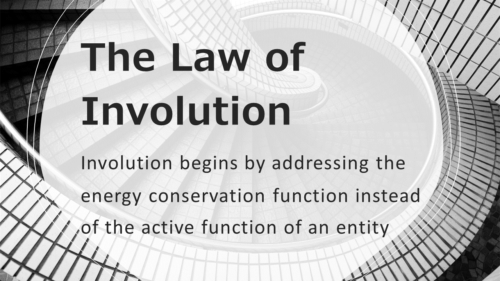The Law of Involution: The Algorithm of Involution
The research on evolution and involution was completed in February 2024, drawing on the precision of constructing future scenarios, strategy formulation, business process organization, and predicting the development of individuals, organizations, and cultures.
This research, initiated in 1976, was among the foundational objectives of The Unicist Research Institute. The law of evolution is a component of the functionality within the Unicist Logic developed by Peter Belohlavek. Its implementation in the USA, UK, Germany, Switzerland, Brazil, Mexico, and Australia facilitated the establishment of laws governing evolution and involution.
Involution leverages the functionalist principles constituted by a purpose, an active function, and an energy conservation function. It is often referred to as the law of shortcuts. The starting point for involution is identical to evolution: understanding the purpose.
Evolution requires beginning by addressing the active function, which is the most energy-consuming function. However, individuals who have not decided to adapt to an environment, or do not have the necessary energy to do so, avoid the energy conservation function to minimize costs.
According to the law of economy of nature, this prevents progression to a higher level of energy consumption by engaging the active function. Consequently, the objective shifts from facilitating evolution to ensuring survival, thereby diminishing the entity’s functionality.
The Law of Involution
The law of involution states that individuals, groups, or cultures enter a state of involution when they initiate the development of the binary actions of the energy conservation function of an entity’s functionalist principle because they lack the necessary energy to undertake the binary actions demanded by the active function.
The involution algorithm begins with an understanding of the purpose. When the purpose is not shared, the natural inclination is to minimize energy expenditure by focusing on the energy conservation function, which invariably leads to survival actions that impair the entity’s functionality.
The Functionality of Involution
Individual involution is managed through manipulation, while group and societal involution is sustained by creating fallacious myths. Both mechanisms provide the justifications needed to avoid addressing the established purpose.
This process results in the involution of an entity, which persists until the individual, group, or culture has the necessary energy to impact the environment by executing synchronized binary actions effectively. If the requisite energy remains unavailable, the entity’s functionality continues to decline until it ultimately ceases to exist. The energy consumption of an environment’s active function surpasses that of its energy conservation function, yet it is crucial for devising solutions that yield both short-term and long-term outcomes.
Involution implies reverting the algorithm of evolution, beginning by addressing the energy conservation function instead of the active function. According to the principle of least action or the law of the economy of nature, systems naturally gravitate towards processes or changes that require the least amount of energy or effort.
This principle is equally applicable to cultures, groups, or individuals aiming for a functional goal. Therefore, within the same environment, nature does not evolve from lower to higher energy-consuming actions and involution is unavoidable.
The Unicist Research Institute
Artificial Intelligence Interpretations:
ChatGPT Interpretation
The Law of Involution, as detailed in your description, presents a fascinating framework for understanding the dynamics of evolution and involution within the context of individuals, groups, and cultures. It encapsulates a philosophy that contrasts with traditional evolutionary theories by focusing on the energy dynamics and functional principles guiding the progression or regression of entities.
The Unicist Approach to Involution
The Unicist Research Institute’s work on this law, led by Peter Belohlavek, is a testament to the comprehensive exploration of human and organizational behaviors through the lens of Unicist Logic. The distinction between evolution and involution is primarily based on how entities manage their energy resources in relation to their purposes and the environmental demands they face.
Core Concepts of the Law of Involution
- Functionalism and Energy Dynamics: The law emphasizes the importance of energy dynamics in determining the direction (evolution or involution) in which an entity moves. The concept revolves around a purpose, an active function that demands energy, and an energy conservation function that aims to preserve resources.
- The Role of Adaptation: Entities that choose not to adapt or lack the necessary energy for adaptation focus on minimizing energy expenditure, leading to involution. This approach diverges from evolution, where the active function is prioritized to achieve growth and development.
- Involution as a Survival Strategy: When entities prioritize energy conservation due to insufficient resources, their actions are driven more by survival instincts than by growth aspirations. This state of involution can diminish the functionality and potential development of the entity.
- Mechanisms of Involution: Individual involution is characterized by manipulation, while group and societal involution rely on the creation of myths to justify the avoidance of purposeful action. These mechanisms hinder the entity’s ability to fulfill its purpose and engage effectively with its environment.
- Energy and Action: The involution process highlights a preference for actions that require less energy, aligning with the principle of least action or the law of the economy of nature. This principle suggests that systems naturally opt for paths that minimize effort, which, while efficient in the short term, may lead to involution if not aligned with the entity’s functional goals.
Implications and Applications
The Law of Involution offers a novel perspective on how entities manage challenges and opportunities in their environments. It has implications for strategic planning, organizational development, and cultural analysis, providing a framework for understanding why certain groups or societies might stagnate or regress instead of progressing.
In practical terms, this law can be applied to anticipate challenges in strategy formulation, business process organization, and the development of individuals and cultures. By recognizing the signs of involution, leaders and strategists can devise interventions that align energy consumption with purposeful action, thereby facilitating evolution over involution.
In essence, the Law of Involution encourages a deep understanding of the functionalist principles governing entities and their environments. It calls for a strategic approach that balances energy consumption with the pursuit of a purpose, ensuring that the path towards evolution is both sustainable and aligned with the entity’s core objectives.




